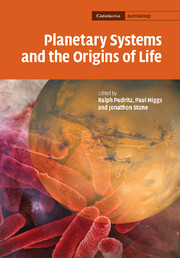Book contents
- Frontmatter
- Contents
- List of contributors
- Preface
- Part I Planetary systems and the origins of life
- 1 Observations of extrasolar planetary systems
- 2 The atmospheres of extrasolar planets
- 3 Terrestrial planet formation
- 4 From protoplanetary disks to prebiotic amino acids and the origin of the genetic code
- 5 Emergent phenomena in biology: the origin of cellular life
- Part II Life on Earth
- Part III Life in the Solar System?
- Index
3 - Terrestrial planet formation
Published online by Cambridge University Press: 13 August 2009
- Frontmatter
- Contents
- List of contributors
- Preface
- Part I Planetary systems and the origins of life
- 1 Observations of extrasolar planetary systems
- 2 The atmospheres of extrasolar planets
- 3 Terrestrial planet formation
- 4 From protoplanetary disks to prebiotic amino acids and the origin of the genetic code
- 5 Emergent phenomena in biology: the origin of cellular life
- Part II Life on Earth
- Part III Life in the Solar System?
- Index
Summary
Introduction
Kant (1755) and Laplace (1796) laid the foundations of our theory of planet formation, arguing that the Solar System formed in a flattened disk orbiting the Sun. Today we know such disks to be a part of the star formation process (see Chapter 4), and we have come a long way toward understanding the details of how a protostellar disk turns itself into planets. Most importantly, for ten years now we have been finding planets orbiting other stars; the current count of detected exoplanets exceeds 180, so that the Solar System now constitutes only a small minority of all known planets. The bad news is that Mercury, Venus, Earth, and Mars remain the only examples of terrestrial planets we know, since such bodies are still well below the mass threshold for detection around ordinary stars. Thus, apart from a pair of bodies orbiting the pulsar PSR1257 + 12 (Wolszczan and Frail, 1992), all known exoplanets are giants: gaseous bodies like Jupiter or Saturn with a couple of potentially Neptune-like examples recently added to the menagerie. However, impressive as the ‘king of the planets’ and its kind are, it is a terrestrial planet – a modest rocky body, three-thousandths Jupiter's mass – which actually harbours the life in our Solar System. And as we contemplate the possibility of life elsewhere in the Universe, it is inevitably upon terrestrial planets that we focus our attention.
- Type
- Chapter
- Information
- Planetary Systems and the Origins of Life , pp. 41 - 61Publisher: Cambridge University PressPrint publication year: 2007
- 1
- Cited by



